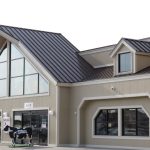
Standing seam metal roofs have become a popular choice for both residential and commercial buildings due to their durability, longevity, energy efficiency, and sleek, modern aesthetic. They offer a unique platform for mounting a variety of rooftop applications—all without penetrating the roof.
A key component that makes standing seam roofs so versatile is the standing seam metal roof clamp. These clamps, engineered for a variety of applications, provide a non-penetrative, secure attachment method, making them an indispensable tool in the metal roofing industry.
Standing seam metal roof clamps enhance the roof system’s overall performance, functionality, and longevity by preserving its integrity while ensuring a strong, reliable point of attachment. They also ensure the roof remains structurally sound and weathertight over time. Here are some of the many applications for standing seam roof clamps.
Solar panel systems
One of the most popular applications of standing seam roof clamps is for solar panel installation. Standing seam metal roofing is a natural choice for mounting rooftop solar panels as they can be mounted directly to the seams, which serve as the inherent (and cost-free) rail structures with which solar modules are typically attached to other roof types.
With metal roofing outlasting the service life of a solar photovoltaic (PV) system, standing seam roofs offer a sustainable and cost-effective mounting solution for solar panel installation. The clamp interfaces install easily and preserve the roof’s warranty—no holes, no leaks. By tightly gripping the seams, the clamps create a stable and secure attachment to transfer environmental loads into the building structure.
Snow retention systems
Rooftop avalanches cause hundreds of millions of dollars in property damage, personal injury, and even deaths each year, creating a life-safety issue. Standing seam metal roof clamps are commonly used to secure snow guards firmly in place while evenly distributing the snow’s sliding force. This helps provide effective snow management in a controlled manner, preventing sudden and hazardous snow slides.
Snow retention systems are particularly beneficial for commercial buildings, schools, and homes in areas with moderate or heavy snowfall, mitigating rooftop avalanches and significantly reducing the safety risks to pedestrians and property, with a penetration-free system lasting the roof’s life.
HVAC systems

Heating, ventilation, and air conditioning (HVAC) systems are commonly installed on commercial rooftops and require a secure, non-penetrating mounting solution that will not compromise the roofing material. Standing seam clamps offer a safe and stable attachment method for HVAC equipment, such as air conditioning units, vents, exhaust fans, stack/flue bracing, and condensate lines.
Using standing seam clamps to fasten HVAC equipment securely eliminates the risk of water infiltration or long-term damage resulting from traditional methods of the past. This ensures the system is securely mounted while preserving the roof’s integrity, safeguarding it from potential leaks and thermal fatigue.
Roof access and fall protection systems
Rooftop access is essential year-round whether installing, inspecting, or maintaining rooftop equipment. Metal roofing, especially in inclement weather like rain or snow, can become slippery, increasing the risk of falls.
When used to anchor walkways, guardrails, or fall-arrest systems, standing seam clamps provide a secure, non-penetrating attachment solution that protects the roof’s structural integrity. Given the dead and live loads the systems need to carry, it is critical to ensure the clamps can support these ancillaries in a safe and reliable manner.
In all applications, it is important to select clamps that are engineered and properly tested for the specific standing seam profile to withstand the load requirements of the application. For permanent fall protection systems, it is important to use clamps that are durable enough to last the roof’s life and are backed by the manufacturer’s warranty.
Wind performance systems
One of metal roofing’s defining features is its superior performance in high-wind conditions. This is mainly due to its attachment methods and interlocking installation, where the side joints of the roof panels are married to each other and the building’s structure, reducing the ability of wind to disrupt the panels.
Standing seam metal roofing has a distinct advantage over other roof types by serving as a “structural” covering. This means it can be engineered to withstand extreme wind forces, transferring all environmental loads directly into the building’s secondary structure. Some standing seam profiles are specifically designed to withstand extremely high forces, making metal roofing the choice for high-wind regions.
Installing standing seam wind clamps is the most cost-effective method of strengthening a standing seam metal roof. It is also the simplest and least intrusive solution, improving wind resistance by as much as two or three times in many cases.
Rooftop accessories and equipment
Standing seam metal roofs are ideal for mounting a variety of rooftop accessories and equipment, such as satellite dishes, security cameras, light fixtures, lightning protection, antennas, equipment screens, electrical conduits, and gas piping. Standing seam roof clamps provide a practical and efficient way to attach these accessories and equipment without penetrating the roof or compromising its structural integrity.
Whether installing gas piping or mounting satellite receptors for improved communication, standing seam clamps can be easily attached. They ensure a strong, stable connection without intrusive drilling or bolting, which could cause leaks or void warranties.
Roof signage
For commercial buildings, standing seam roofs are the ideal location for installing advertising signage or branding materials. Clamps can secure signage brackets or frames directly to the seams, providing a strong and stable base for the display without penetrating the building envelope.
Whether it is for business logos, advertisements, or identification signs, standing seam clamps allow for easy, efficient installation of signage systems on metal roofs (and walls), eliminating the need for screws or other invasive fasteners and preserving the lifespan of the claddings.
However, it is important to remember not every clamp is the same.
Selecting the appropriate seam clamps

The specific application for any given ancillary mounting should always consider factors such as the roof manufacturer’s approval and the service loads that the attachment will experience. It is a precise science rather than guesswork.
Seam clamps are structural elements that should be specifically designed, engineered, and tested for their failure load capacities to ensure reliable application and performance throughout the roof’s life. Factors such as metallurgical compatibility and long-term durability should also be considered to assure
long-lasting performance.
What sets one clamp apart from another?
Clamps used for different purposes may vary significantly in design. Snow guards must withstand forces parallel to the roof’s slope, while those for solar mounting must handle “negative normal” loads perpendicular to the slope. Each clamp’s holding strength capacity must be tested accordingly and compared against specific project design loads, including considerations for seismic forces.
Testing clamp performance
Seam clamps transfer loads (forces) into the roof panels and structure, making seam and roof panel profile-specific testing indispensable. Clamp holding strength varies depending on the seam profile, material, and gauge thickness. Therefore, each clamp should undergo certified testing for load capacity in multiple load directions on the same seam profile, gauge thickness, material type, and roof manufacturer as used for the project. Therefore, it is a matrix of many possible combinations. One size may “fit” all but does not render the same holding strength.
Key recommendations
- Utilize clamps recommended by the roof manufacturer and verified through certified testing to withstand intended design loads on a job-specific basis.
- Ensure clamps are manufactured under audited quality standards.
- Verify a product’s proven track record and warranty details to secure long-term reliability (read the fine print.)
- Limit your liability with proof of all the above from the vendor.
Rob Haddock, president of the Metal Roof Advisory Group and CEO/founder of S-5!, brings more than five decades of industry expertise to the field of metal roofing. With a background spanning contracting, roof forensics, and building envelope science, Haddock is a respected authority in the field. For more information, visit S-5.com or rmhaddock.com.





